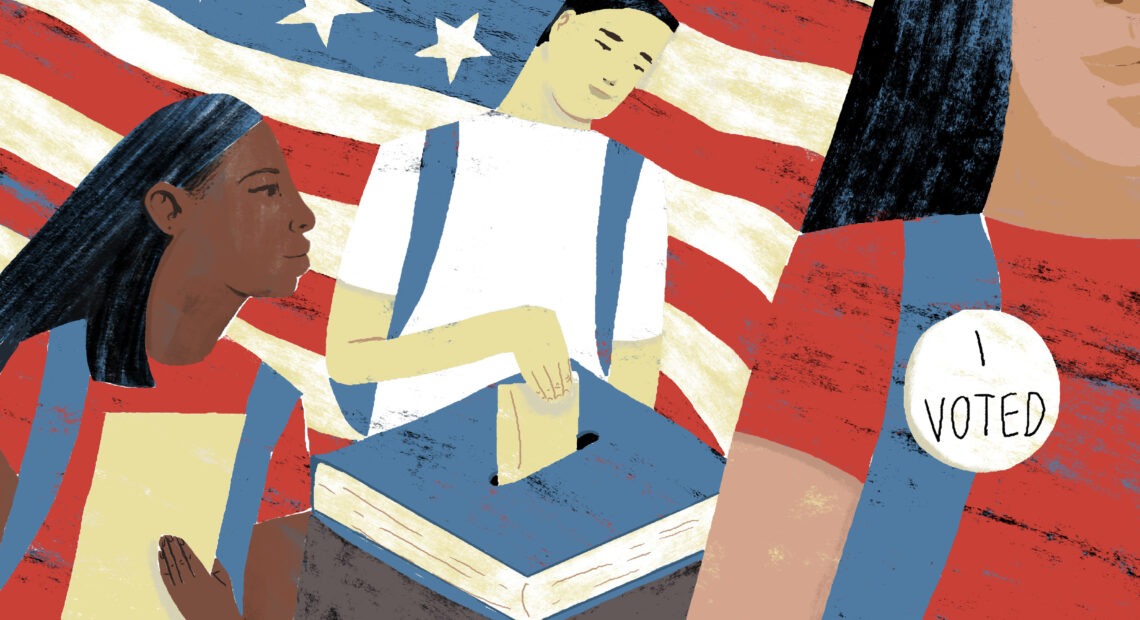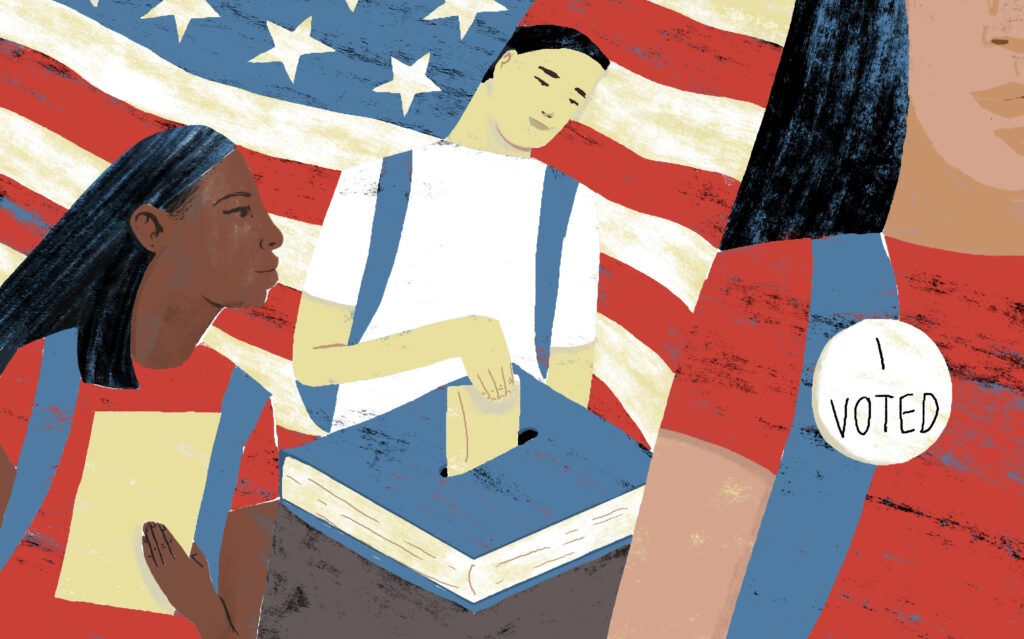
Now Is A Good Time To Talk To Kids About Civics
BY ANYA KAMENETZ, CORY TURNER & SYLVIE DOUGLIS
If you’ve been riding an emotional, politics-fueled rollercoaster in 2021 (not to mention 2020), believe us: Your kids have noticed. Here’s a quick primer from Life Kit on how to talk with your kids about politics — and, even get them thinking about civics.
Process your own emotions and make home a safe space.
Kids can see that we’re on edge. They are naturally self-centered, and they’ll assume your stress is about them. Be honest and tell them, “Dad/Mom is a little nervous about what’s happening in the country.” It’s helpful for kids’ social and emotional development to hear you naming your emotions.
At the same time, it’s not great for you or them to be mainlining the news 24/7, so try your hardest to turn off the TV or the radio, put away your phone and connect — especially over meals and other key moments during the day.

Teaching civics to kids can help them eventually be more engaged voters. CREDIT: LA Johnson/NPR
“We can control the amount of information. We can control the amount of exposure,” Rosemarie Truglio, senior vice president of curriculum and content at Sesame Workshop, told us when we talked to her about parenting during intense news events.
Ask: “What have you heard and how are you feeling?”
Parents and caregivers, this question is a golden line to have in your back pocket at all times — even when there is no election, no riots, no pandemic casting a long shadow over our lives. Tara Conley, a media researcher at Montclair State University, says adults should choose a quiet moment to check in with their kids, maybe at the dinner table or at bedtime.
The idea, she says, is to allow kids to “ask questions about what they’re seeing, how they’re feeling and what do they think.” In other words: Give kids a safe space to reflect and share. And give yourself a chance to dispel any scary rumors or misinformation they may have come across.
And this is key: Your job, first and foremost, is to listen.
Use this as a learning opportunity
Looking for a silver lining to all the recent upheaval? Well, the Annenberg Public Policy Center’s annual Constitution Day survey found a marked increase last year in the awareness among average Americans about their rights, like free speech and the structures of government. And, just over half can name the executive, legislative and judicial branches, an all-time high on this survey.
Obviously, though, that good news comes as our kids (and the rest of us) are being buffeted by hurricane-force winds of misinformation and conspiracy theory. According to a new NPR/NewsHour/Marist Poll conducted earlier this week, 38% of Americans polled said they still do not trust the results of the 2020 election — even though there has been no credible evidence of widespread voter fraud.
To be active, empowered citizens, kids need to be able to sort fact from fiction, especially when that fiction is coming from our own elected leaders. And that requires they build a strong foundation of basic knowledge — about history, geography and our political system.
“The more you know, the more you can know,” says Ashley Berner, a professor at Johns Hopkins who studies how schools teach civics. In fact, she says, research shows students who have more time with social studies actually do better in other subjects, too.
The 2020 election, the insurrection at the U.S. Capitol, and President-elect Joe Biden’s inauguration present a perfect opportunity to help kids build this foundation of facts. With my (Anya’s) older daughter, we looked at a map of the distribution of House seats between the two parties, and talked about why the Vice President is allowed to break a tie in the Senate. My younger one, who is four, wanted to see Washington, D.C. on a map, and to know that it was pretty far away.
Ashley Berner also suggests a simple, civically-minded walk outside. “Talk about what institutions are public and what are private. So which things have we decided as a community that we’re going to support, like road-building, or parks or libraries?”
Put this moment in the context of history — including our “hard history”
Many of the rioters who invaded the U.S. Capitol were known white nationalists. Some carried Confederate flags. Black Capitol Police have described the racist taunts of their attackers. And all of this follows a concerted effort by the President and many Republicans to disenfranchise voters — particularly Black Americans. In short: Our nation’s painful history of racism is integral to an understanding of this moment.
The United States and its democracy are a work-in-progress, and in order for children to understand the role we all have to play in its improvement, they need to learn about its failures as well as its successes. “I think the highest form of patriotism is self-reflection and saying, ‘Hey, this is what we’ve done wrong,'” says Hasan Kwame Jeffries, a history professor at Ohio State University.
Presenting kids with a less-than-honest version of history, especially the nation’s racial history, risks leaving them feeling confused, alienated, even betrayed when they’re exposed to facts that don’t fit that rosy narrative. This came up when we spoke with Taylor Pittman, an advisor to a program called Cultures of Dignity, which is dedicated to “civil dialogue” among young people, families and educators.
A high-school senior in New Orleans, Pittman told us about the time her class visited a former plantation that depended on labor from enslaved people. She says the tour guide wanted to talk about, “The agriculture, and ‘It’s so pretty. And look at the nature,'” especially the plantation’s oak trees.
“And then when we got back onto the bus, my teacher was like, ‘The oak trees are where they used to hang people. They used to have beatings there.’ And we talked about how everything they said there at that plantation was wrong,” Pittman remembers.
Jeffries says, when talking about race and identity with kids, the point is not to focus solely on the hard stuff but to strike a delicate balance, like when he talks with his daughters.
“Race couldn’t always be discrimination and injustice or slavery and Jim Crow … I had to begin to consciously say, ‘You got to balance the good with the bad. You got to balance the pain with the joy.’ Right? The hardship with the love.”
Don’t demonize the other side. We need to teach kids the fine art of tolerant disagreement.
It feels like the United States has never been so divided. But, in an interview late last year, Berner said we need to actively expose our children to a range of opinions.
“It’s so important for young people to be engaged in conversations about meaning and purpose and different political viewpoints.” In fact, she says, historically, “civic formation is the prime reason why modern democracy started funding education in the first place.”
According to this view, classrooms should be like a little lab where students practice having reasonable, evidence-based debate. “In fact, most of our peer nations have made it a priority to explicitly teach children about the ways that different groups in society actually see the world differently,” says Berner.
Emotions are running high right now, but, in the run-up to the 2020 election, Truglio told us that, at all costs, we should resist the temptation to simply label the other side “bad guys” or “evil.” It’s not helpful, and it may increase fear and confusion.
Instead, child development experts say, we should condemn actions, such as violence and hateful speech. And try to talk about why some might make choices we find painful or ugly. Empathy, perspective-taking — it’s hard to do, but it’s also absolutely necessary in a democracy.
Jeffries adds, “We’re afraid to talk about politics … As my 5-year-old says, ‘That don’t make no sense!’ You got to let people know where you stand. Provide children evidence. Provide them with stories.”
Put civics into action.
Biden’s inaugural committee is highlighting this year that Martin Luther King Day is a federally designated National Day of Service. Invite your kids to join you in the nuts and bolts of civic action — like writing letters and cards to lonely seniors, or collecting cans for a food pantry. It’s empowering, and it builds a sense of belonging and agency, says Jeffries. “Society is service. You have to serve other people.”
This story was originally published in October 2020. It’s been updated and republished.
The podcast portion of this episode was produced by Sylvie Douglis.
We’d love to hear from you. Leave us a voicemail at 202-216-9823, or email us at LifeKit@npr.org.
For more Life Kit, subscribe to our newsletter.
9(MDAyOTk4OTc0MDEyNzcxNDIzMTZjM2E3Zg004))















